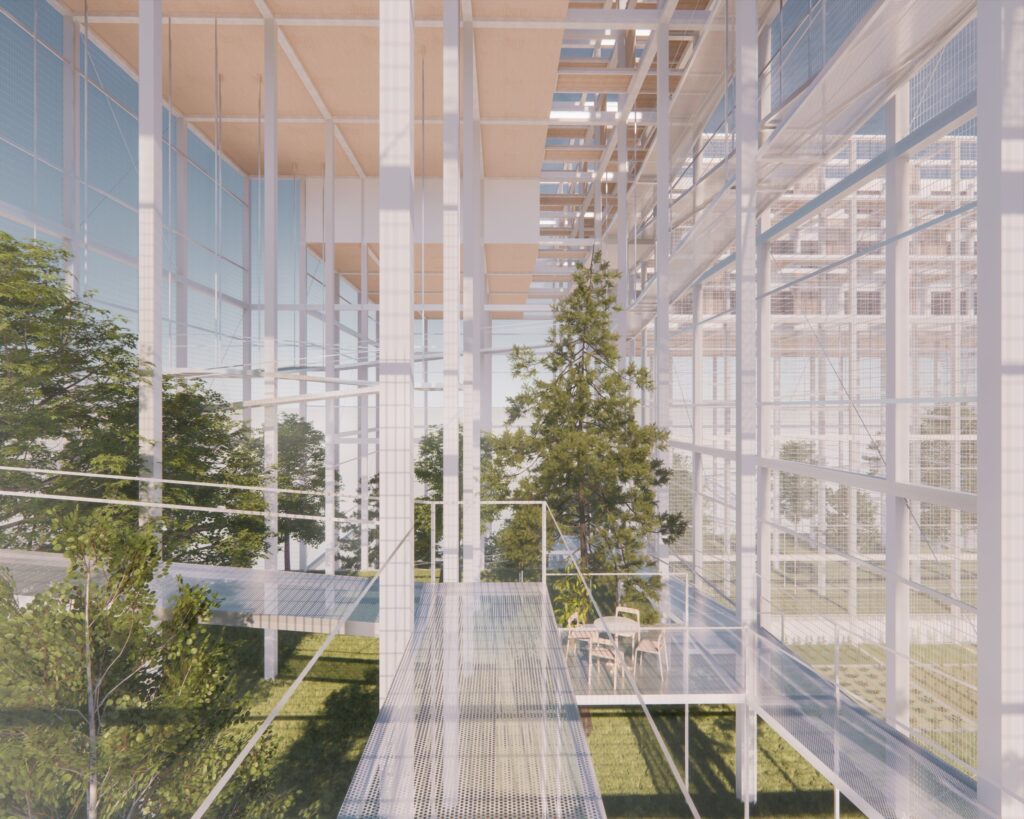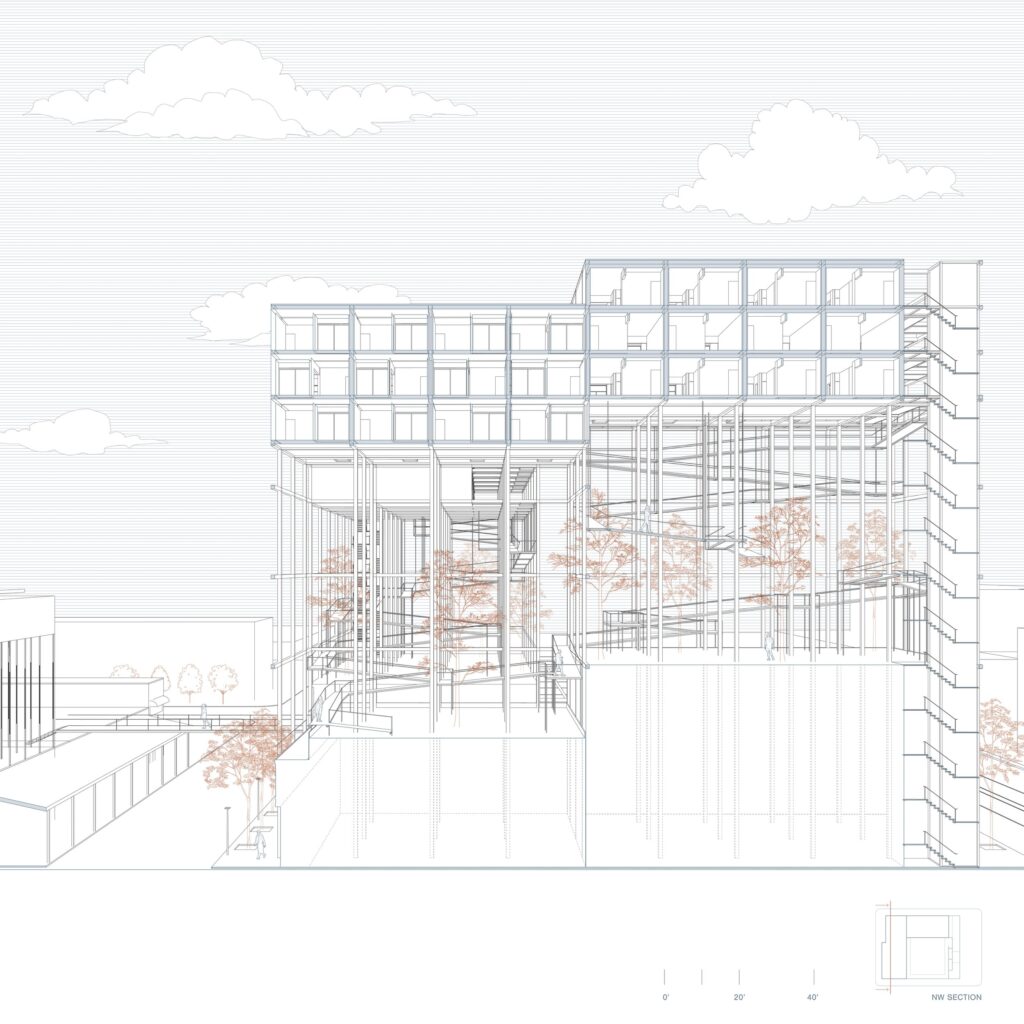Alumna Abigail Happel Featured in Madame Architect

This story was originally published in Madame Architecture by Julia Gamolina on January 11, 2023.
Abby Happel [BEDA ’22] pursued her undergraduate degree in architecture at NC State’s College of Design. She is interested in the study of biophilic design principles and their influence on human health and the environment. She is currently a Master of Architecture student at UC Berkeley.
Abby also has a robust social media presence on Instagram (@abby.architecture) and Tiktok (@abbyhappel), where she shares a lot of her work, tips, and experiences as an architecture student. She spoke with Madame Architect on studio culture, transparency and embracing complexity.
JG: Why did you decide to study architecture?
AH: Growing up, I was always an art kid. I was always drawing or building something for fun, which evolved throughout my life into a deeper passion for design. I applied to undergraduate design programs at the end of high school and got into the Art + Design program at North Carolina State University, where I planned to study fashion and fibers design.
However, after taking a mixed design studio during my first semester there, I was immediately influenced by my studio professor to switch into the Architecture program. Being primarily a Professor of Architecture, she noticed my attributes as a student and designer and believed I was best fit for architecture. I trusted her judgment and made the switch, never looking back ever since. I fell in love with the subject, and now can’t imagine pursuing anything else.


What was the favorite project you worked on in school?
One of the favorite projects I’ve worked on is my ‘Urban Agricultural Utopia’, completed during the first semester of my graduate degree at UC Berkeley. During the first few weeks of the semester I developed a site master plan with Lucine Lu, Jack Tam, and YuShao Wu, which was one of the most influential collaborative experiences I’ve had. We proposed a way to preserve the Oakland Produce Market and use the air rights above the existing building fabric to develop housing. We explored different urban farming strategies for each block of the master plan to form a collective agricultural community that works in conjunction with the market. Using this framework, each group member chose a block to further develop into their own project for the remaining portion of the semester.
For my individual portion of the project, I lofted residential units above the existing building fabric by an interstitial green space: an unconventional park that can be explored more in section than in plan. The park and residential units spread over four buildings of the existing block, wrapping around the remaining building on the block that is used for rooftop farming practices. Since the project’s site is almost completely void of urban green space, this intervention is aimed to foster a greater interconnection between natural elements and the inhabitants of the site.
What are some of the initiatives you’ve focused on in school, and why?
I have always advocated for mental health in both the culture of the school environment, as well as in the work I put forward. The architecture studio often breeds a certain competitive standard of work that is hard to sustain without compromising proper habits that support physical and mental health. This isn’t talked about enough, which leads many students to feel burnt-out and not fit for the profession.
I have always made a point to contribute a voice towards these issues throughout the relationships I’ve developed with my peers, professors, and program faculty. I also strive to be as transparent as possible about the struggles I have as an architecture student, especially on my social media platforms, because no one should ever feel like they are experiencing them alone.
“I also strive to be as transparent as possible about the struggles I have as an architecture student, especially on my social media platforms, because no one should ever feel like they are experiencing them alone.”
– Abby Happel
When searching for internships and jobs, what are you looking for?
Last summer I had the opportunity to work with ThoughtCraft Architects in Durham, NC and it was such an amazing experience. Everyone in the office was very willing to take the time to teach me and enrich my learning, causing me to grow so much over the course of the internship. I was taught how to work on aspects of different projects that I was unfamiliar with, instead of being confined to what I already knew, or what I could already contribute. Knowing the impact this has had on my growth, I am searching for an internship this summer that will value the learning process in a similar way.
You have a wonderful presence on Instagram and TikTok with videos of your architectural work. It’s amazing! Tell me about what engages people the most, and what content people love to see. What feedback do you get?
Thank you so much! I started posting my architecture videos to TikTok about two years ago, and I only recently joined IG reels, but I truly enjoy what it has evolved to and the people I’ve met along the way.
Lately I’ve been documenting the projects I’ve been working on at UC Berkeley, some of which is hands-on work, modeling, presentation pin-ups, and overall studio culture. I feel like this is what people have been tuning into the most, as this is the true essence of architecture school that we have been missing since the pandemic and online classes. A lot of my following are younger architecture students or high school students who hope to pursue a similar path, so I try to answer all the questions they have and be as transparent about my experience as possible.


What’s important to you? What inspires you?
During my undergraduate education, I noticed a pattern of natural preservation and sustainability at the root of all my projects. While investigating and synthesizing these concepts, I became familiar with the discussion of biophilia in architecture. I have dedicated most of my projects and case studies to the exploration of biophilic design ever since, growing a deeper understanding and dedication to the topic.
In addition to the environmental benefits of introducing biophilia in an urban setting, I am fascinated with the aspect of biophilic design that connects humans to nature. I believe the presence of natural elements can achieve considerable improvements in an individual’s well-being, as well as increase social connections and community resilience.
What do you hope to do in your career?
I don’t completely know yet, but my goal is to always be in a place or position that enables me to grow in my knowledge and passion. I hope to find my niche within the field, but I also wish to never stop challenging myself and taking on new things. The field of architecture can be so dynamic, so I’d rather explore it than shy away from its complexities.
“I hope to find my niche within the field, but I also wish to never stop challenging myself and taking on new things. The field of architecture can be so dynamic, so I’d rather explore it than shy away from its complexities.”
— Abby Happel
Who do you look up to? Both in terms of women in architecture, and in general.
I have always looked up to Zaha Hadid. When hearing about Zaha, there is always a lot of focus that goes towards the complex geometries she embraced, and therefore the engineering and construction and finances that are tangential to her work.
However as a female designer that grew up with Zaha as an inspiration, I am even more inspired by the potency of her writing and theory. She advocated for women in creative industries and leadership positions; she used biophilic and human centric design principles; and the integration of landscape, architecture and city into comprehensive works. Aside from this, her work is inspiring in the way that it integrates futuristic technologies, and cross-disciplinary collaboration.
Finally Abby, what advice would you give to those in high school now, choosing their field of study?
Do not suppress or ignore your passions, no matter how big or small they are. To find a way to combine your passions with your personal strengths and incorporate them into your career path is so powerful. Discard any presumptions or fears you may have towards a particular field of study if that’s what is getting in the way of you studying it. The best path for you isn’t always the easiest, safest, or the most obvious.
This post was originally published in College of Design Blog.


